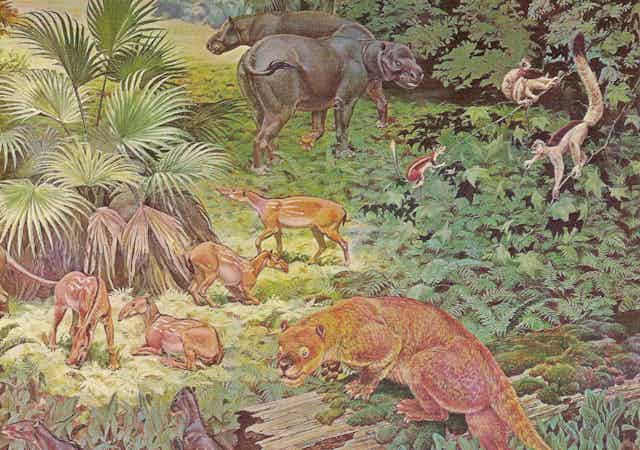The animal kingdom is full of colour. Animals use it for camouflage, to advertise themselves and even as various forms of protection. But we haven’t been paying as much attention to what colours now-extinct mammals might have had – until now.
By matching samples of organic material to their chemical make up we’ve been able to determine the colour of extinct bats and our novel research, published in PNAS, has the potential to work out colours in lots of other organisms.
Fossils usually only leave us information about the harder parts of an animal such as bones and shells. Occasionally, however, soft tissues, such as feathers, skin or hair are left behind.
Palaeontologists have previously discovered dark, organic residues in fossils that for decades were thought to be remnants of decaying bacteria from the surface of the dead bodies. However, in 2008 it was suggested that these little bacteria-like structures were in fact preserved melanosomes, the special sub-units of a cell that carry the pigment melanin. This is the primary source of pigment for feathers, hair and skin across the animal kingdom.

Looking at a fossilised feather from the Cretaceous period (roughly 105m years old) with an alternating black and white pattern revealed that the microscopic structures were only present in the black bands. If these structures were bacteria as originally thought, they would have covered the entire feather. The fact that the structures were missing from the white areas, which would lack pigment, suggested the organic matter was actually melanosomes. What’s more, the structures were aligned along the fine branches of the feather (barbs and barbules), another characteristic feature of melanosomes.
Colour clues
Different melanosomes have different shapes. Of the two main types, reddish brown pheomelanosomes are shaped like tiny little meatballs (500 nanometres in diameter). Black eumelanosomes, meanwhile, are shaped like little narrow sausages and are about twice the size at one micrometre in length.
Subsequent studies have used these facts to reconstruct colour patterns of dinosaurs, with the shape of melanosomes found in different places of a fossil indicating its pigment colour and even iridescence. But until now, little work has been done to characterise the chemistry of the pigment in these fossil melanosomes and there is little evidence to prove that the melanosome shape actually reflects the original colour in fossils.

Using a combination of techniques, we have been able to describe melanin and melanosomes in animals ranging from fish to birds to squids, and for the first time, frogs, tadpoles and mammals. We looked at the shape of the melanosomes under a scanning electron microscope. We also analysed the molecules directly associated with these structures and found that their chemical signature resembled modern melanin samples. However, there were also some clear differences.
We speculated that perhaps the melanin had changed its chemical composition over millions of years buried in the ground under high pressure and temperature. In order to test this, we subjected melanin to even higher pressures and temperatures to replicate within 24 hours the conditions it would have experienced over millions of years. The chemical signature from our cooked melanin then looked more similar to the fossils.
Furthermore, we found that we could quantify the difference between red and black melanin in both fresh and fossil samples. This meant we could test the idea that melanosome shape correlated to chemical colour in the skin of the now fossilised animal – and we found that it did.

Most excitingly, this also meant that we could for the first time determine the colour of long-extinct mammals just by studying their fossils. We looked at two fossilised bat species from Messel in Germany that lived in the Eocene period (around 49m years ago). Based on the small spherical melanosomes – which are indicative of pheomelanosomes – and the chemical signature associated with the related pigment, we were able to infer that these bats originally sported a reddish brown coat. This means they did not look much different from modern bats.
The study of fossil melanin and other pigments is a blooming research area. Knowing something about fossilised creatures’ original colours will not only make Jurassic Park sequels more realistic, but will also inform us about the whole ecology of dinosaurs and other extinct animals.

